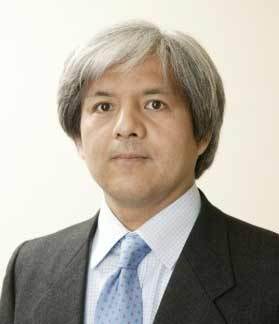Marc Abrahams's Blog, page 280
March 9, 2016
Effect of audience boredom on power-hungry-persons [Podcast 54]
Aggressive boredom and power-hungry people dominate this week’s Improbable Research podcast.
SUBSCRIBE on Play.it, iTunes, or Spotify to get a new episode every week, free.
This week, Marc Abrahams —with dramatic readings by Jean Berko Gleason — tells about:
How the power-hungry respond to aggressive boredom — Fodor, Eugene M., and David P. Wick (2009). ‘Need for Power and Affective Response to Negative Audience Reaction to an Extemporaneous Speech.’ Journal of Research in Personality, vol. 43: pp. 721–26.
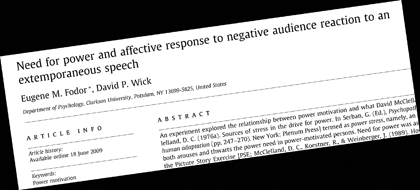
The mysterious John Schedler or the shadowy Bruce Petschek perhaps did the sound engineering this week.
The Improbable Research podcast is all about research that makes people LAUGH, then THINK — real research, about anything and everything, from everywhere —research that may be good or bad, important or trivial, valuable or worthless. CBS distributes it, on the CBS Play.it web site, and on iTunes and Spotify).

March 7, 2016
Ear gauging – and surgical reversal techniques
“There is an ever increasing market for surgical repair of gauged ears.” informs an article in The American Journal of Cosmetic Surgery Vol. 32, No. 4, 2015. If you haven’t come across the concept of ‘gauged ears’ before, the authors provide a short explanation and historical context:
“Ear gauging, also known as ‘ear plugging’, can be seen worldwide throughout history. Ear gauging has been employed for eons and has been found in the mummies and relics of ancient civilizations. Gautama Buddha, the founder of Buddhism in Eastern India circa 500 bc, had stretched earlobes. Stretched lobes were noted in Otzi the Iceman, Europe’s oldest known natural human mummy, who lived around 3300 bc. In Egypt, the golden death mask of King Tutankhamen features stretched ears with holes of 10-mm diameter.”
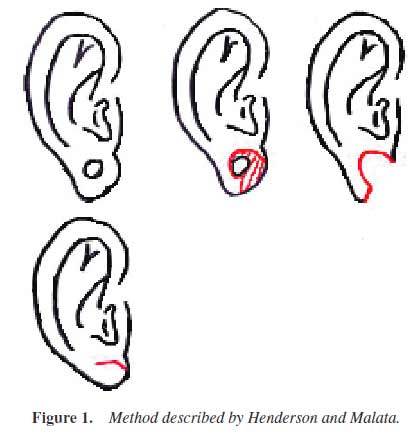 Nowadays however, those who are in possession of ears which have been gauged, and are thinking of “entering the job market for professional employment” might consider having them surgically de-gauged. The article goes on to describe suitable techniques [as at right], and introduces a new one – called The Star Technique.
Nowadays however, those who are in possession of ears which have been gauged, and are thinking of “entering the job market for professional employment” might consider having them surgically de-gauged. The article goes on to describe suitable techniques [as at right], and introduces a new one – called The Star Technique.
Note: With graphic photos which those of a squeamish disposition may prefer not to see.
Non squeamish? See:
The Gauged Earlobe: A Review of Current Treatment Methods and Presentation of a New Technique

March 5, 2016
Why the Beatles Succeeded but Broke Up: the Math(s)
Over the years, many investigators have examined possible factors which might have led to the breakup of The Beatles, but Professor Tadashi Yagi (Faculty of Economics, Doshisha University, Kyoto, Japan) is one of the few* scholars to have approached the subject from a mathematical standpoint. The professor takes the view that incentives for collaborating within a team tend to decrease as the knowledge of each member is shared over time. Thus the breakup of the band was “an inevitable consequence of the superstar collaboration.”
His formula for the quality of music produced by the group is as follows:

[see full paper for definitions of variables]
“Based on this equation, one can finally understand why the final album recorded by the Beatles, Abbey Road, is critically acclaimed as a masterpiece, even though it was recorded when the group was on the verge of breaking up: the period during which the album was recorded coincided with the creative peak of each member of the band.”
See: Nonlinear Effects of Superstar Collaboration: Why the Beatles Succeeded but Broke Up, Applied Economics and Finance, Vol. 2 , No. 2 ; May 2015
*Note [1]: Few, but not the only. See, for example: ‘Assortative Matching, Reputation, and the Beatles Breakup’ (University of Michigan Economics Department, 2001)
Note [2]: For copyright reasons, we are not permitted to reproduce any Beatles music on this website, so instead the video above shows The Rutles performing ‘Cheese and Onions’ from ‘Yellow Submarine Sandwich’ (Soundtrack 1/17/1969).

March 4, 2016
Interview with the scientists who wrote the paper about Pokémon
Aggie TV interviewed Matan Shelomi, Andrew Richards and Ivana Li — three of the four co-authors of the paper “A Phylogeny and Evolutionary History of the Pokémon“, which was published in the Annals of Improbable Research, vol. 18, no 4, June/July 2012, pages 15-17:
Their institution, The University of California, Davis, wrote about the paper and its impact, in a piece headlined “Taking a Poke at Pokemon“.

March 3, 2016
Ig Nobel in Oslo — Friday afternoon, March 4
The 2016 Ig Nobel EuroTour begins Friday, March 4, in Oslo, Norway — the first ever Ig Nobel event in Norway. Please join us!
Where and when: The University of Oslo, in Sophus Lie’s Auditorium, at 4:00 pm.
Click here for DETAILS.

Thorsten Altenkirch joins Luxuriant Flowing Hair Club for Scientists (LFHCfS)
Thorsten Altenkirch has joined the Luxuriant Facial Hair Club for Scientists (LFHCfS) and the Luxuriant Facial Hair Club for Scientists (LFHCfS). He says:
This is a photo of my work outfit. The hammer is the hammer of science.
THORsten Altenkirch, Ph.D, LFHCfS
Reader, School of Computer Science
Nottingham University
Nottingham, UK


Jerk analysis – and its relevance to safe driving
 Would one expect to see an increased amount of jerks amongst drivers involved in accidents, rather than drivers who have not been involved in accidents? Yes, explain Omar Bagdadi [pictured] (of VTI, Swedish National Road and Transport Research Institute, Borlänge, Sweden) and András Várhelyib (of Trafik och väg, Lunds Tekniska Högskola, Sweden), in a paper for the journal Accident Analysis & Prevention. The core concept of the study was the idea that perhaps car divers who exhibit jerky driving might be more likely to become involved in accidents. If so, this could provide a way around the problems involved in assessing intelligent in-vehicle systems. The research determined that :
Would one expect to see an increased amount of jerks amongst drivers involved in accidents, rather than drivers who have not been involved in accidents? Yes, explain Omar Bagdadi [pictured] (of VTI, Swedish National Road and Transport Research Institute, Borlänge, Sweden) and András Várhelyib (of Trafik och väg, Lunds Tekniska Högskola, Sweden), in a paper for the journal Accident Analysis & Prevention. The core concept of the study was the idea that perhaps car divers who exhibit jerky driving might be more likely to become involved in accidents. If so, this could provide a way around the problems involved in assessing intelligent in-vehicle systems. The research determined that :
“Jerk analyses make it possible to identify safety critical driving behaviour or ‘accident prone’ drivers.”
“It is thus expected to see an increased amount of jerks amongst driver involved in accidents than drivers that have not been involved in accidents.”
See: Jerky driving – An indicator of accident proneness? in: Accident Analysis & Prevention, Volume 43, Issue 4, July 2011, Pages 1359–1363.
Also see: (related to a different type of jerk) Towards a Theory of Jerks (help wanted)

March 2, 2016
Fold when wet, if naked underwater [Podcast 53]
A Russian research project that towed naked women swimmers underwater, at high speed, to compare their skin with that of dolphins— that’s the subject of this week’s Improbable Research podcast.
SUBSCRIBE on Play.it, iTunes, or Spotify to get a new episode every week, free.
This week, Marc Abrahams —with dramatic readings by Nicole Sharp — tells about:
Aleyev’s towing-naked-swimmers-underwater-at-high-speed experiments — Yuri Glebovich Aleyev (1977). Nekton . The Hague: Dr W. Junk. See 264–78.
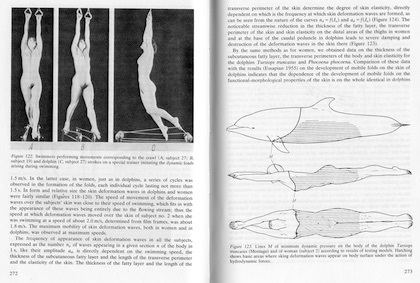
[BONUS: Two reviews of the book Nekton.]
[BONUS: This week, Nicole Sharp’s Tumblr, FYFD, is doing a special series about Walking on Water.]
The mysterious John Schedler or the shadowy Bruce Petschek perhaps did the sound engineering this week.
The Improbable Research podcast is all about research that makes people LAUGH, then THINK — real research, about anything and everything, from everywhere —research that may be good or bad, important or trivial, valuable or worthless. CBS distributes it, on the CBS Play.it web site, and on iTunes and Spotify).

March 1, 2016
The Further We Travel the Faster We Go, They Calculate
Mathematically speaking, distance and travel time now — in this technological age — have a relatavistical relationship, even at speed far, far lower than the speed of light. This new study explains:
“Further We Travel the Faster We Go,” Levente Varga, András Kovács, Géza Tóth, István Papp, Zoltán Néda, PLoS ONE, 11(2): 2016, e0148913. The authors, at Babeş-Bolyai University, Romania, Edutus College, Hungary, and the Hungarian Central Statistical Office, report:
“The average traveling speed increases in a nontrivial manner with the travel distance. This leads to scaling-like relations on quite extended spatial scales, for all mobility modes taken together and also for a given mobility mode in part. We offer a wide range of experimental results, investigating and quantifying this universal effect and its measurable causes. The increasing traveling speed with the travel distance arises from the combined effects of: choosing the most appropriate travelling mode; the structure of the travel networks; the travel times lost in the main hubs, starting or target cities; and the speed limit of roads and vehicles….
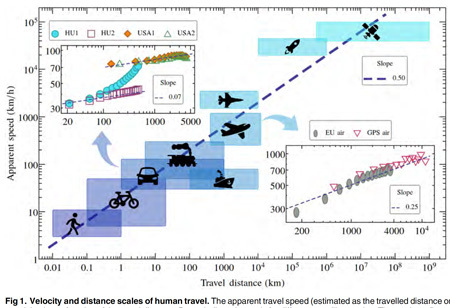
“From our everyday experience we have learned, that the travelling time does not scale linearly with the travel distance. It might take several hours to travel at distances of a few hundreds of miles, but not significantly more to travel at the opposite side of the Earth. This is of course due to the fact that for smaller distances we use slower transportation modes, cars or commuting trains with many stops, while at larger scale we travel faster by airplanes or high-speed trains. Similar observations can be made for urban travel. In cities, travels at shorter distances are dominated by bus travel or walking, while at larger distances faster modes (trains or metro) are used. We recall here the surprising and extreme result, according to which in some major cities (like Boston or Lisbon) the commuting time is roughly independent of the commuting distance. Analysing the British public transportation system, it has been also proved that in general urban travels are multimodal with significant connection times between different modes. The combined effects of these modes and waiting times leads to a sub-linear dependence of the travelling time as a function of the travel distance.
“Surprisingly however, even if we do focus on the same travelling mode we still find an increasing effective speed with distance….”

February 29, 2016
Recent progress in bullshit studies
In November last year, Improbable drew readers’ attention to a newly published experimental study by Gordon Pennycook (University of Waterloo, ON, Canada) et alli in the journal Judgment and Decision Making, “Reception and Detection of Pseudo-Profound Bullshit”. We can now report that the same journal has published a rejoinder, in  the form of a commentary by Dr Craig Dalton, [pictured] (who is a Conjoint Senior Lecturer at the School of Medicine and Public Health, The University of Newcastle, Australia.) It’s entitled : Bullshit for you; transcendence for me. A commentary on “On the reception and detection of pseudo-profound bullshit”
the form of a commentary by Dr Craig Dalton, [pictured] (who is a Conjoint Senior Lecturer at the School of Medicine and Public Health, The University of Newcastle, Australia.) It’s entitled : Bullshit for you; transcendence for me. A commentary on “On the reception and detection of pseudo-profound bullshit”
“Seeming ‘nonsense’ and paradox has been at the heart of many wisdom traditions – the famous Zen koan – ‘what is the sound of one hand clapping’ may seem nonsense but it and other koans have inspired great insight not through ‘making sense’ but through creating a cognitive gap that allows opportunity for transcendence and reflection and potentially new learning.
[…]
A flower, the random sounds of a waterfall, a willow tree playing in the breeze, or the random scattering of autumn leaves, may lack the intention of profundity but they can all lead to transcendence and open us to beauty – as can a random statement generated by a computer.”
This new paper, however, has already prompted a re-rejoinder – again from Gordon Pennycook et alli : ‘It’s still bullshit: Reply to Dalton (2016)’
“That it is possible for someone to find meaning in a statement does not prevent it from being bullshit. Indeed, bullshit that is not found at least somewhat meaningful would be rather impotent. Consider the evangelizing of politicians and so-called spin-doctors, for example. Often, their goal is to say something without saying anything; to appear competent and respectful without concerning themselves with the truth. It is not the understanding of the recipient of bullshit that makes something bullshit, it is the lack of concern (and perhaps even understanding) of the truth or meaning of statements by the one who utters it. Our original study concluded that people who are receptive to statements randomly generated without concern for meaning (i.e., bullshit) are less, not more, analytic and logical as well as more intelligent. Dalton’s commentary does not undermine this conclusion.”
Bearing in mind this recent plethora of bullshit studies, Improbable asks, ‘Has the time come for a scholarly journal devoted entirely to the study of bullshit?’ If so, may we suggest a provisional title, as coined by Professor James A. Fredal, of the Department of English at The Ohio State university, “Taurascatics”
Further reading: Brian D. Earp who is a Visiting Scholar at the Hastings Center Bioethics Research Institute in Garrison, New York, writes on ‘The Unbearable Asymmetry of Bullshit’ for Quillette.

Marc Abrahams's Blog
- Marc Abrahams's profile
- 14 followers


